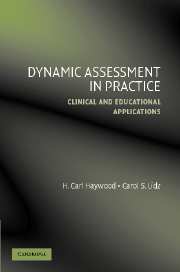Book contents
- Frontmatter
- Contents
- Preface
- Foreword, by Kenneth A. Dodge
- Foreword, by Thomas Oakland
- PART ONE THEORY AND PRINCIPLES
- PART TWO APPLICATIONS
- 4 Dynamic Assessment in Clinical Settings
- 5 Dynamic Assessment in Educational Settings
- 6 Applying Dynamic Assessment with Young Children
- 7 Applying Dynamic Assessment with School-Age Children
- 8 Applying Dynamic Assessment with Adults and Seniors
- 9 Writing Reports and Developing IEPs and Service Plans with Dynamic Assessment
- 10 Unresolved Issues, Conclusions, and Recommendations
- APPENDIX A TESTS REFERRED TO IN THE TEXT THAT DO NOT BELONG TO THE AUTHORS
- APPENDIX B SOURCES OF DYNAMIC ASSESSMENT MATERIALS
- References
- Author Index
- Subject Index
- Tests and Testing Materials Index
8 - Applying Dynamic Assessment with Adults and Seniors
Published online by Cambridge University Press: 04 December 2009
- Frontmatter
- Contents
- Preface
- Foreword, by Kenneth A. Dodge
- Foreword, by Thomas Oakland
- PART ONE THEORY AND PRINCIPLES
- PART TWO APPLICATIONS
- 4 Dynamic Assessment in Clinical Settings
- 5 Dynamic Assessment in Educational Settings
- 6 Applying Dynamic Assessment with Young Children
- 7 Applying Dynamic Assessment with School-Age Children
- 8 Applying Dynamic Assessment with Adults and Seniors
- 9 Writing Reports and Developing IEPs and Service Plans with Dynamic Assessment
- 10 Unresolved Issues, Conclusions, and Recommendations
- APPENDIX A TESTS REFERRED TO IN THE TEXT THAT DO NOT BELONG TO THE AUTHORS
- APPENDIX B SOURCES OF DYNAMIC ASSESSMENT MATERIALS
- References
- Author Index
- Subject Index
- Tests and Testing Materials Index
Summary
Even though they are typically not in school and usually may be presumed to be free of psychopathology or developmental disabilities, adults (including, for this chapter, adolescents and senior citizens), encounter many situations in which it is especially useful to be able to identify obstacles to good performance and to specify ways to overcome those obstacles. Integrating dynamic assessment of cognitive functioning and potential into a more comprehensive assessment that includes personality and social variables can enable examiners to go well beyond the standard vocational aptitude assessments that characterize, for example, employment services. Even when psychological barriers, including psychopathology (see Chapter 4), may be impeding the performance of adults, one can identify the cognitive component of those barriers and find ways to overcome at least that aspect. In fact, improving logical thinking can be a key to liberation of the personality and to improved personal, social, and occupational performance (e.g., Beck, 1976, 1991; Haywood, 2000; Haywood & Menal, 1992; Meichenbaum, 1977, 1982). In this chapter we discuss the application of dynamic assessment in work with adults, from adolescence into maturity and old age, using the usual combination of theoretical aspects, assessment techniques, and some specific assessment instruments.
THE TASKS OF CHILDHOOD AND ADULTHOOD
Whereas the primary task of childhood is to gain knowledge of the world and competence in interacting with one's environment, with heavy emphasis on education, the primary tasks of adulthood are work, child rearing, social interaction, and learning in non-school contexts.
- Type
- Chapter
- Information
- Dynamic Assessment in PracticeClinical and Educational Applications, pp. 205 - 234Publisher: Cambridge University PressPrint publication year: 2006



